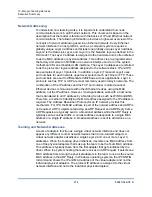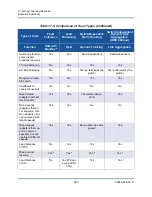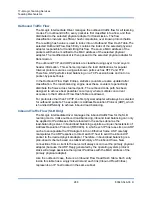
17–QLogic Teaming Services
Executive Summary
277
83840-546-00 D
Smart Load Balancing enables both transmit and receive load balancing based on
the Layer 3/Layer 4 IP address and TCP/UDP port number. In other words, the
load balancing is not done at a byte or frame level but on a TCP/UDP session
basis. This methodology is required to maintain in-order delivery of frames that
belong to the same socket conversation. Load balancing is supported on 2 to 8
ports. These ports can include any combination of add-in adapters and LAN on
Motherboard (LOM) devices. Transmit load balancing is achieved by creating a
hashing table using the source and destination IP addresses and TCP/UDP port
numbers.The same combination of source and destination IP addresses and
TCP/UDP port numbers will generally yield the same hash index and therefore
point to the same port in the team. When a port is selected to carry all the frames
of a given socket, the unique MAC address of the physical adapter is included in
the frame, and not the team MAC address. This is required to comply with the
IEEE 802.3 standard. If two adapters transmit using the same MAC address, then
a duplicate MAC address situation would occur that the switch could not handle.
Receive load balancing is achieved through an intermediate driver by sending
gratuitous ARPs on a client-by-client basis using the unicast address of each
client as the destination address of the ARP request (also known as a directed
ARP). This is considered client load balancing and not traffic load balancing.
When the intermediate driver detects a significant load imbalance between the
physical adapters in an SLB team, it will generate G-ARPs in an effort to
redistribute incoming frames. The intermediate driver (ASP) does not answer ARP
requests; only the software protocol stack provides the required ARP Reply. It is
important to understand that receive load balancing is a function of the number of
clients that are connecting to the system through the team interface.
SLB receive load balancing attempts to load balance incoming traffic for client
machines across physical ports in the team. It uses a modified gratuitous ARP to
advertise a different MAC address for the team IP Address in the sender physical
and protocol address. This G-ARP is unicast with the MAC and IP Address of a
client machine in the target physical and protocol address respectively. This
causes the target client to update its ARP cache with a new MAC address map to
the team IP address. G-ARPs are not broadcast because this would cause all
clients to send their traffic to the same port. As a result, the benefits achieved
through client load balancing would be eliminated, and could cause out-of-order
frame delivery. This receive load balancing scheme works as long as all clients
and the teamed system are on the same subnet or broadcast domain.
NOTE
IPv6 addressed traffic will not be load balanced by SLB because ARP is not
a feature of IPv6.
















































